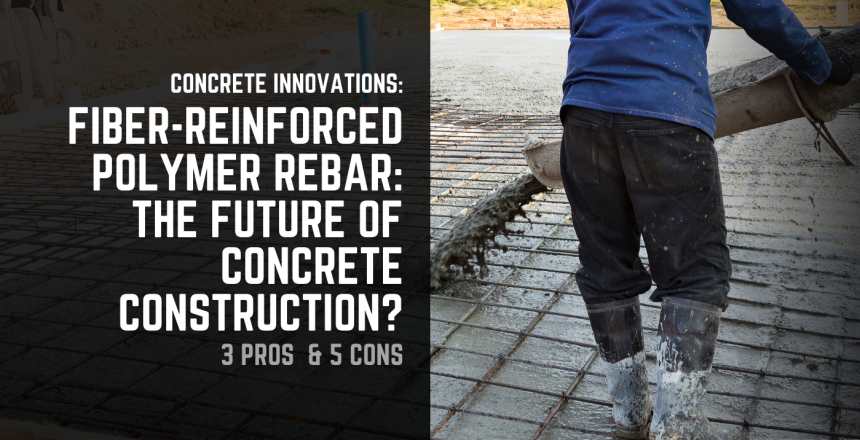Conventional carbon steel rebar has been used for decades to reinforce concrete structures, and its ability to take stress and strain has proven invaluable for construction. But it has some disadvantages that keep it from being a lasting solution for strengthening concrete.
One innovation in this field that hopes to overcome these disadvantages is fiber-reinforced polymer rebar. But with all its advantages over carbon steel, construction companies may not yet be ready to adopt this material.
What Is Fiber-Reinforced Polymer Rebar?
Fiber-reinforced polymer rebar, or FRP rebar, is a nonmetallic alternative to conventional carbon steel rebar. The rebar itself is made up of many individual fiber filaments in a matrix of polymeric resin. By replacing metallic components with nonmetallic components, FRP rebar can eliminate some of the inherent problems associated with steel rebar. But the characteristics of fiber-reinforced polymer rebar also present their own challenges for construction and engineering.
Types of FRP Rebar
FRP rebar can be made from several different types of filaments, and it can be found in different diameters to meet different construction requirements.
Filaments
About 60-70% of FRP rebar is made of the fiber filaments within the composite. These filaments are often thinner than a piece of human hair. There are three common materials used in fiber-reinforced polymer rebar:
- Glass
- Basalt
- Carbon
Of the three, the most promising for structural integrity is carbon fiber, but it’s also the most expensive.
Polymers
Surrounding the filaments is a polymeric resin. This plastic binding agent keeps the filaments stable and gives them structure. This component makes up about 30-40% of the total composite and is responsible for the rigidity of the rebar.
Pros of Fiber Reinforced Rebar
The lighter, stronger nature of FRP offers advantages over conventional rebar. And by eliminating the most frustrating issue with carbon steel—rusting—fiber reinforced polymer could be a perfect option for certain applications.
Corrosion Resistant
Carbon steel’s biggest problem is its tendency to rust over time. Since concrete is permeable, conventional carbon steel rebar will rust as water penetrates the structure. Add de-icing salts, and the life expectancy of carbon steel drops dramatically. Even with an epoxy coating, rusting rebar is still a serious threat to concrete integrity.
FRP rebar eliminates this concern since the materials are completely inert. Without the weakening effects of rust, FRP rebar can last much longer, even in more extreme weather conditions.
Lighter
FRP rebar is considerably lighter than conventional rebar—about one-third the weight. That weight reduction is especially beneficial for transport and labor requirements.
Stronger
Compared to carbon steel, fiber-reinforced polymer rebar can be as much as 4.5 times stronger. For construction, this equates to less material requirements per square yard of concrete than conventional steel rebar.
Engineered for Strong Bonding
One benefit of using polymers in FRP rebar is that these resins can be formulated to bond better with concrete, helping improve its overall strength.
Cons of Fiber-Reinforced Rebar
Even with its clear benefits, fiber-reinforced polymer doesn’t meet all the criteria of a complete alternative to conventional rebar. From a higher cost to its less pliable composition, FRP falls short of many of carbon steel’s inherent properties.
Higher Cost
Carbon steel rebar is far more affordable than FRP rebar. For glass and basalt FRP, the cost can range between 15% and 25% more per yard. Carbon FRP rebar can be as much as 30% more than steel. For large projects, this cost difference can add up quickly.
Uncertain Fire Resistance
These newer materials still have years of testing and real-world evidence before their fire resistance is well documented. Because of that, some builders are still reluctant to adopt FRP rebar.
Long-Term Deflection Concerns
FRP rebar’s limited history of use lends itself to doubts about its long-term durability. Deflection, or the movement of a concrete structure from its original structural parameters, could be more dramatic in these polymer rebars. Without firm data to demonstrate its deflection
Lower Strain Capacity
Carbon steel is excellent for supporting strain without breaking, but fiber-reinforced polymer rebar tends to snap instead of bending under pressure. This lower capacity typically translates to needing more FRP per square yard to improve the concrete’s ability to handle larger loads.
Lower Ductility
Ductility is one of the warning signs of concrete failure. Conventional steel rebar provides high ductility, but that’s not the case for fiber-reinforced rebar. Carbon steel handles the stretching caused by concrete cracking or shifting, but carbon, glass, and basalt filaments are far more rigid. When FRP rebar is used, repairs need to be made as soon as possible.
Can FRP Rebar Replace Carbon Steel Rebar?
At this point, the likelihood of carbon steel being replaced by FRP is low. Between cost concerns, structural engineering challenges, and the reality that FRP rebar can’t be reshaped in the field, there are too many obstacles for the widespread adoption of this new technology at this time.
But in specific applications, the benefits of FRP rebar could be significant enough to outweigh the challenges it brings. As the technology progresses, we could see improvements in areas like ductility and strain capacity while costs reduce. With these improvements, concrete construction could see dramatic changes to planning, engineering, and budgeting for projects ranging from infrastructure to residential and commercial buildings.



